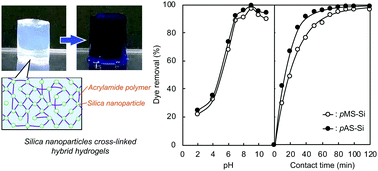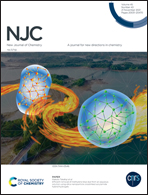Efficient removal of methylene blue dye from an aqueous solution using silica nanoparticle crosslinked acrylamide hybrid hydrogels†
Abstract
The removal of toxic dyes from textile effluents has become a serious concern because of their harmful effects on aquatic environments and human health. Herein, we report acrylamide hydrogels based on reactive copolymers poly(acrylamide-co-3-methacryloxypropyl trimethoxysilane) (pAS) and poly(N-(3-methoxy propyl acrylamide-co-3-methacryloxypropyl trimethoxysilane)) (pMS) crosslinked with silica nanoparticles (Si) for the elimination of methylene blue (MB) dye from aqueous solution; the synthesis of the reactive copolymers was confirmed by 1H NMR spectroscopy and the dispersion of Si in the hydrogels was analysed by the transmission electron microscopy (TEM) and dynamic light scattering (DLS) techniques. The chemical functionalities and morphological characteristics of the crosslinked copolymer hydrogels were characterised by Fourier transform infrared (FTIR) spectroscopy and field-emission scanning electron microscopy (FE-SEM) analysis before and after dye adsorption. The influence of vital operational parameters, such as the impact of the solution pH, contact time, initial dye concentration, adsorbent dose, and temperature, was evaluated. The optimum pH and equilibrium time for MB adsorption were found to be 9 and 120 min, respectively, for both hydrogels. The experimental results indicated that the Langmuir model fitted better than the Freundlich isotherm model, and the maximum adsorption capacities of pMS-Si and pAS-Si were 588.23 and 666.65 mg g−1, respectively, and that the pseudo second-order kinetic model provided the best correlation (R2 > 0.99) in both hydrogels. The adsorption phenomena were natural and impulsive for both hydrogels and were also endothermic, as indicated by the thermodynamic study. Moreover, the pMS-Si and pAS-Si hydrogels exhibited high selectivity towards MB dye among a mixture of the methyl orange and MB dyes. Furthermore, the pMS-Si and pAS-Si hydrogels can be reused in multiple cycles; consequently, the Si-crosslinked acrylamide hydrogels may be a new technology for removing toxic organic dye pollutants even from dilute effluents.



 Please wait while we load your content...
Please wait while we load your content...